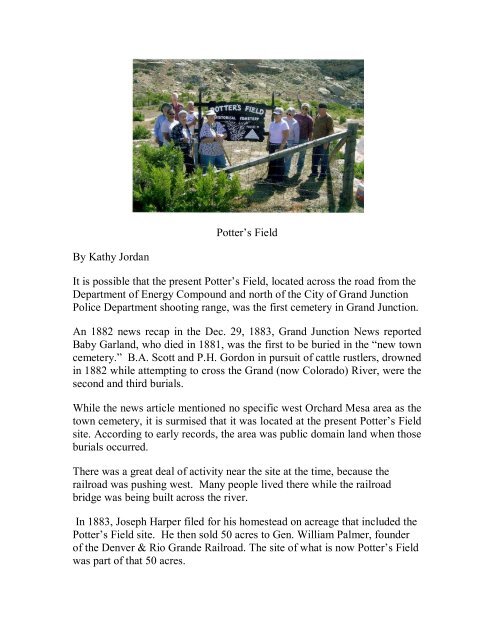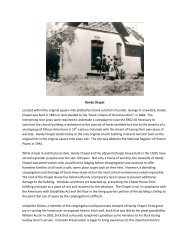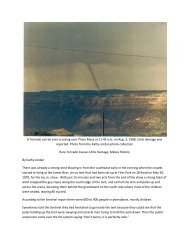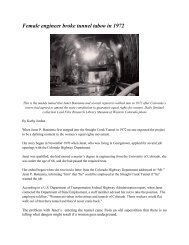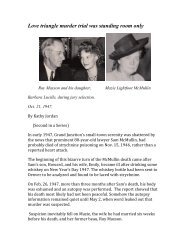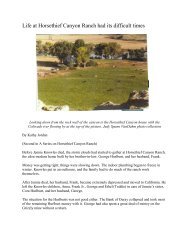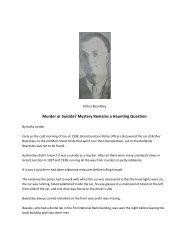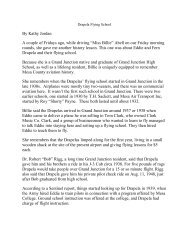Potter's Field - North 7th Street Historic District in Grand Junction ...
Potter's Field - North 7th Street Historic District in Grand Junction ...
Potter's Field - North 7th Street Historic District in Grand Junction ...
Create successful ePaper yourself
Turn your PDF publications into a flip-book with our unique Google optimized e-Paper software.
Potter’s <strong>Field</strong><br />
By Kathy Jordan<br />
It is possible that the present Potter’s <strong>Field</strong>, located across the road from the<br />
Department of Energy Compound and north of the City of <strong>Grand</strong> <strong>Junction</strong><br />
Police Department shoot<strong>in</strong>g range, was the first cemetery <strong>in</strong> <strong>Grand</strong> <strong>Junction</strong>.<br />
An 1882 news recap <strong>in</strong> the Dec. 29, 1883, <strong>Grand</strong> <strong>Junction</strong> News reported<br />
Baby Garland, who died <strong>in</strong> 1881, was the first to be buried <strong>in</strong> the “new town<br />
cemetery.” B.A. Scott and P.H. Gordon <strong>in</strong> pursuit of cattle rustlers, drowned<br />
<strong>in</strong> 1882 while attempt<strong>in</strong>g to cross the <strong>Grand</strong> (now Colorado) River, were the<br />
second and third burials.<br />
While the news article mentioned no specific west Orchard Mesa area as the<br />
town cemetery, it is surmised that it was located at the present Potter’s <strong>Field</strong><br />
site. Accord<strong>in</strong>g to early records, the area was public doma<strong>in</strong> land when those<br />
burials occurred.<br />
There was a great deal of activity near the site at the time, because the<br />
railroad was push<strong>in</strong>g west. Many people lived there while the railroad<br />
bridge was be<strong>in</strong>g built across the river.<br />
In 1883, Joseph Harper filed for his homestead on acreage that <strong>in</strong>cluded the<br />
Potter’s <strong>Field</strong> site. He then sold 50 acres to Gen. William Palmer, founder<br />
of the Denver & Rio <strong>Grand</strong>e Railroad. The site of what is now Potter’s <strong>Field</strong><br />
was part of that 50 acres.
There were no known burials dur<strong>in</strong>g the time Palmer owned the property.<br />
Palmer died <strong>in</strong> 1909.<br />
In 1911, the Palmer estate sold the Potter’s <strong>Field</strong> property to C.L. Connelly.<br />
Accord<strong>in</strong>g to records there were five known burials <strong>in</strong> Potter’s <strong>Field</strong>, two <strong>in</strong><br />
1911 and two <strong>in</strong> 1913, and the last burial <strong>in</strong> 1936.<br />
Connelly sold the property to James Rank<strong>in</strong> <strong>in</strong> February 1919, and Rank<strong>in</strong><br />
resold the cemetery to the City of <strong>Grand</strong> <strong>Junction</strong> that same day. The first<br />
time the property was referred to as “Potter’s <strong>Field</strong>” came after the city had<br />
purchased the property.<br />
Because those buried there, or their families, didn’t purchase perpetual care<br />
from the city, <strong>Grand</strong> <strong>Junction</strong> doesn’t ma<strong>in</strong>ta<strong>in</strong> it.<br />
Research for this column turned up other “Potter’s fields”. A current map of<br />
the area shows a Potter’s <strong>Field</strong> at the northeast corner of B ¾ and 26 Roads<br />
where it turns south to go to the Department of Energy. A 1964 map <strong>in</strong> a<br />
cemetery report done by the City of <strong>Grand</strong> <strong>Junction</strong> identifies Block E as<br />
“Potter’s <strong>Field</strong>”. Records show that <strong>in</strong> 1894 the county purchased a small<br />
piece of ground about onehalf acre just to the north of the better known<br />
“Potter’s <strong>Field</strong>”. It is not known if the county used it then as a burial ground,<br />
but at some po<strong>in</strong>t the city may have acquired the property. The county also<br />
operated a “Paupers <strong>Field</strong>” <strong>in</strong> what is now Section D of the Orchard Mesa<br />
Cemetery.<br />
In 1985 the local chapter of the Telephone Pioneers of American approached<br />
the City of <strong>Grand</strong> <strong>Junction</strong> about adopt<strong>in</strong>g the longforgotten and neglected<br />
Potter’s <strong>Field</strong>. Each year they have a “work party” to clean up this historic<br />
cemetery and <strong>in</strong> do<strong>in</strong>g so have preserved, protected and cared for it for the<br />
last 15 years.<br />
This year was no exception. On May 17, 11 members cut down weeds and<br />
picked up five bags of trash. They trimmed the sagebrush, careful not to<br />
remove it because sagebrush slows erosions. They also pa<strong>in</strong>ted the gate and<br />
oiled the cedar sign that they had made for the cemetery several years ago.<br />
Members do all of this at their own expense to preserve this important part<br />
of our heritage. Once it is gone, it can’t be replaced. On the back of the sign<br />
are the names of those who are known to be buried <strong>in</strong> the cemetery.
Thank you members of the Telephone Pioneers for your efforts <strong>in</strong> preserv<strong>in</strong>g<br />
this earlyday cemetery <strong>in</strong> memory of those pioneers who gave so much <strong>in</strong><br />
the early days to help establish the young city on the Western Frontier. The<br />
past needs to be recognized to ensure a better future.


